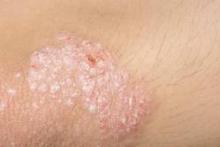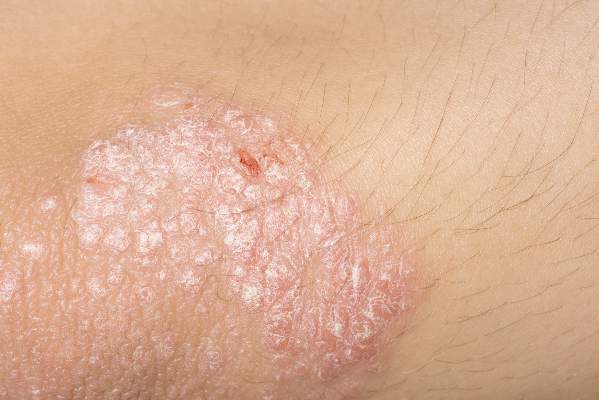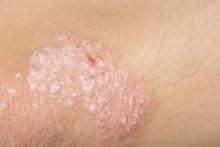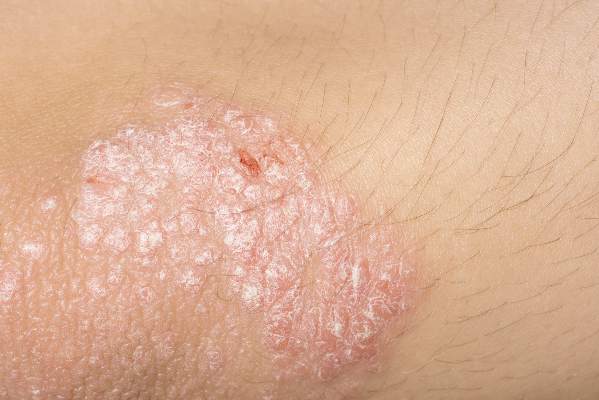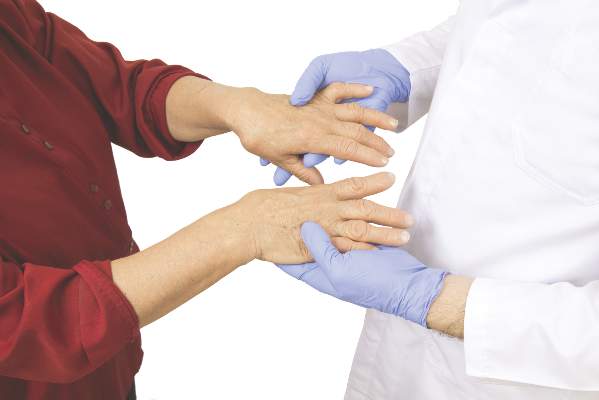User login
Psoriasis and Acne Worse in Winter, Milder in Summer
Psoriasis and acne appear to be susceptible to seasonal variations of clearing and worsening, with an analysis revealing both conditions maintained a significant trend of summer clearing and winter worsening, according to a research letter published in the Journal of the American Academy of Dermatology.
Using Physician’s Global Assessment scales for psoriasis and acne, Dr. Vanessa Lindsay Pascoe and Dr. Alexandra Boer Kimball, both of Massachusetts General Hospital, Boston, collected data from 5,468 psoriasis patients and 9,301 acne patients between June 2011 and May 2014 in the New England area. Among the psoriasis patient group, 16% were seen in the summer, 25% in the fall, 31% in the winter, and 28% in the spring. The trend was similar for acne patients, with 18% seen in the summer, 25% in the fall, 28% in the winter, and 29% in the spring. There were no significant seasonal differences in age or sex for either group.
The percentage of psoriasis patients with clear/almost clear disease was highest in the summer at 20.4%, while the percentage of patients with moderate/severe disease was highest in the winter at 40.5%. For acne, the percentage of patients with clear/almost clear disease was highest in the fall at 17.5%, and the percentage of patients with moderate/severe disease was highest in the winter at 45.9%. Fewer psoriasis and acne patients presented to the clinic in the summer, which the researchers suggested could be due to disease improvement.
“Although the climate of the Northeastern United States may not generalize to regions with less seasonal variation, providers may consider seasonal adjustment of acne plans as they have traditionally done for psoriasis,” the authors wrote. “For example, they may wait until after winter to taper a systemic antibiotic for acne, just as some providers may wait until spring to change systemic psoriasis treatments.”
Read the full article in the Journal of the American Academy of Dermatology.
Psoriasis and acne appear to be susceptible to seasonal variations of clearing and worsening, with an analysis revealing both conditions maintained a significant trend of summer clearing and winter worsening, according to a research letter published in the Journal of the American Academy of Dermatology.
Using Physician’s Global Assessment scales for psoriasis and acne, Dr. Vanessa Lindsay Pascoe and Dr. Alexandra Boer Kimball, both of Massachusetts General Hospital, Boston, collected data from 5,468 psoriasis patients and 9,301 acne patients between June 2011 and May 2014 in the New England area. Among the psoriasis patient group, 16% were seen in the summer, 25% in the fall, 31% in the winter, and 28% in the spring. The trend was similar for acne patients, with 18% seen in the summer, 25% in the fall, 28% in the winter, and 29% in the spring. There were no significant seasonal differences in age or sex for either group.
The percentage of psoriasis patients with clear/almost clear disease was highest in the summer at 20.4%, while the percentage of patients with moderate/severe disease was highest in the winter at 40.5%. For acne, the percentage of patients with clear/almost clear disease was highest in the fall at 17.5%, and the percentage of patients with moderate/severe disease was highest in the winter at 45.9%. Fewer psoriasis and acne patients presented to the clinic in the summer, which the researchers suggested could be due to disease improvement.
“Although the climate of the Northeastern United States may not generalize to regions with less seasonal variation, providers may consider seasonal adjustment of acne plans as they have traditionally done for psoriasis,” the authors wrote. “For example, they may wait until after winter to taper a systemic antibiotic for acne, just as some providers may wait until spring to change systemic psoriasis treatments.”
Read the full article in the Journal of the American Academy of Dermatology.
Psoriasis and acne appear to be susceptible to seasonal variations of clearing and worsening, with an analysis revealing both conditions maintained a significant trend of summer clearing and winter worsening, according to a research letter published in the Journal of the American Academy of Dermatology.
Using Physician’s Global Assessment scales for psoriasis and acne, Dr. Vanessa Lindsay Pascoe and Dr. Alexandra Boer Kimball, both of Massachusetts General Hospital, Boston, collected data from 5,468 psoriasis patients and 9,301 acne patients between June 2011 and May 2014 in the New England area. Among the psoriasis patient group, 16% were seen in the summer, 25% in the fall, 31% in the winter, and 28% in the spring. The trend was similar for acne patients, with 18% seen in the summer, 25% in the fall, 28% in the winter, and 29% in the spring. There were no significant seasonal differences in age or sex for either group.
The percentage of psoriasis patients with clear/almost clear disease was highest in the summer at 20.4%, while the percentage of patients with moderate/severe disease was highest in the winter at 40.5%. For acne, the percentage of patients with clear/almost clear disease was highest in the fall at 17.5%, and the percentage of patients with moderate/severe disease was highest in the winter at 45.9%. Fewer psoriasis and acne patients presented to the clinic in the summer, which the researchers suggested could be due to disease improvement.
“Although the climate of the Northeastern United States may not generalize to regions with less seasonal variation, providers may consider seasonal adjustment of acne plans as they have traditionally done for psoriasis,” the authors wrote. “For example, they may wait until after winter to taper a systemic antibiotic for acne, just as some providers may wait until spring to change systemic psoriasis treatments.”
Read the full article in the Journal of the American Academy of Dermatology.
Psoriasis and acne worse in winter, milder in summer
Psoriasis and acne appear to be susceptible to seasonal variations of clearing and worsening, with an analysis revealing both conditions maintained a significant trend of summer clearing and winter worsening, according to a research letter published in the Journal of the American Academy of Dermatology.
Using Physician’s Global Assessment scales for psoriasis and acne, Dr. Vanessa Lindsay Pascoe and Dr. Alexandra Boer Kimball, both of Massachusetts General Hospital, Boston, collected data from 5,468 psoriasis patients and 9,301 acne patients between June 2011 and May 2014 in the New England area. Among the psoriasis patient group, 16% were seen in the summer, 25% in the fall, 31% in the winter, and 28% in the spring. The trend was similar for acne patients, with 18% seen in the summer, 25% in the fall, 28% in the winter, and 29% in the spring. There were no significant seasonal differences in age or sex for either group.
The percentage of psoriasis patients with clear/almost clear disease was highest in the summer at 20.4%, while the percentage of patients with moderate/severe disease was highest in the winter at 40.5%. For acne, the percentage of patients with clear/almost clear disease was highest in the fall at 17.5%, and the percentage of patients with moderate/severe disease was highest in the winter at 45.9%. Fewer psoriasis and acne patients presented to the clinic in the summer, which the researchers suggested could be due to disease improvement.
“Although the climate of the Northeastern United States may not generalize to regions with less seasonal variation, providers may consider seasonal adjustment of acne plans as they have traditionally done for psoriasis,” the authors wrote. “For example, they may wait until after winter to taper a systemic antibiotic for acne, just as some providers may wait until spring to change systemic psoriasis treatments.”
Read the full article in the Journal of the American Academy of Dermatology.
Psoriasis and acne appear to be susceptible to seasonal variations of clearing and worsening, with an analysis revealing both conditions maintained a significant trend of summer clearing and winter worsening, according to a research letter published in the Journal of the American Academy of Dermatology.
Using Physician’s Global Assessment scales for psoriasis and acne, Dr. Vanessa Lindsay Pascoe and Dr. Alexandra Boer Kimball, both of Massachusetts General Hospital, Boston, collected data from 5,468 psoriasis patients and 9,301 acne patients between June 2011 and May 2014 in the New England area. Among the psoriasis patient group, 16% were seen in the summer, 25% in the fall, 31% in the winter, and 28% in the spring. The trend was similar for acne patients, with 18% seen in the summer, 25% in the fall, 28% in the winter, and 29% in the spring. There were no significant seasonal differences in age or sex for either group.
The percentage of psoriasis patients with clear/almost clear disease was highest in the summer at 20.4%, while the percentage of patients with moderate/severe disease was highest in the winter at 40.5%. For acne, the percentage of patients with clear/almost clear disease was highest in the fall at 17.5%, and the percentage of patients with moderate/severe disease was highest in the winter at 45.9%. Fewer psoriasis and acne patients presented to the clinic in the summer, which the researchers suggested could be due to disease improvement.
“Although the climate of the Northeastern United States may not generalize to regions with less seasonal variation, providers may consider seasonal adjustment of acne plans as they have traditionally done for psoriasis,” the authors wrote. “For example, they may wait until after winter to taper a systemic antibiotic for acne, just as some providers may wait until spring to change systemic psoriasis treatments.”
Read the full article in the Journal of the American Academy of Dermatology.
Psoriasis and acne appear to be susceptible to seasonal variations of clearing and worsening, with an analysis revealing both conditions maintained a significant trend of summer clearing and winter worsening, according to a research letter published in the Journal of the American Academy of Dermatology.
Using Physician’s Global Assessment scales for psoriasis and acne, Dr. Vanessa Lindsay Pascoe and Dr. Alexandra Boer Kimball, both of Massachusetts General Hospital, Boston, collected data from 5,468 psoriasis patients and 9,301 acne patients between June 2011 and May 2014 in the New England area. Among the psoriasis patient group, 16% were seen in the summer, 25% in the fall, 31% in the winter, and 28% in the spring. The trend was similar for acne patients, with 18% seen in the summer, 25% in the fall, 28% in the winter, and 29% in the spring. There were no significant seasonal differences in age or sex for either group.
The percentage of psoriasis patients with clear/almost clear disease was highest in the summer at 20.4%, while the percentage of patients with moderate/severe disease was highest in the winter at 40.5%. For acne, the percentage of patients with clear/almost clear disease was highest in the fall at 17.5%, and the percentage of patients with moderate/severe disease was highest in the winter at 45.9%. Fewer psoriasis and acne patients presented to the clinic in the summer, which the researchers suggested could be due to disease improvement.
“Although the climate of the Northeastern United States may not generalize to regions with less seasonal variation, providers may consider seasonal adjustment of acne plans as they have traditionally done for psoriasis,” the authors wrote. “For example, they may wait until after winter to taper a systemic antibiotic for acne, just as some providers may wait until spring to change systemic psoriasis treatments.”
Read the full article in the Journal of the American Academy of Dermatology.
Agent blocks STAT3 protein and might prevent AML relapse
The discovery of a new therapeutic target site on the STAT3 oncoprotein – a protein that interferes with chemotherapy by halting deaths of cancerous cells – could cut down on acute myeloid leukemia (AML) relapse in chemoresistant patients, according to research published in Angewandte Chemie.
The STAT3 protein – which stands for “signal transducer and activator of transcription 3” – is a suspected factor in the relapse of nearly 40% of children with AML. A team of researchers from Rice University, working with colleagues at Baylor College of Medicine and the University of Texas MD Anderson Cancer Center, all in Houston, developed a proximity-driven rhodium (II) catalyst known as MM-206, which blocks STAT3 function by identifying the STAT3 coiled-coil domain as a novel ligand-binding site and delivering a naphthalene sulfonamide inhibitor, thus halting the disease promoting effects of STAT3.
The effects were replicated in tumor growth models and testing in a leukemia mouse model suggest this approach can be used to shut down STAT3 activity in AML patients, according to coauthor Dr. Zachary Ball of the department of chemistry at Rice.
Read the full article here: Angew Chem Int Ed Engl. 2015 Sep 7. doi: 10.1002/anie.201506889.
The discovery of a new therapeutic target site on the STAT3 oncoprotein – a protein that interferes with chemotherapy by halting deaths of cancerous cells – could cut down on acute myeloid leukemia (AML) relapse in chemoresistant patients, according to research published in Angewandte Chemie.
The STAT3 protein – which stands for “signal transducer and activator of transcription 3” – is a suspected factor in the relapse of nearly 40% of children with AML. A team of researchers from Rice University, working with colleagues at Baylor College of Medicine and the University of Texas MD Anderson Cancer Center, all in Houston, developed a proximity-driven rhodium (II) catalyst known as MM-206, which blocks STAT3 function by identifying the STAT3 coiled-coil domain as a novel ligand-binding site and delivering a naphthalene sulfonamide inhibitor, thus halting the disease promoting effects of STAT3.
The effects were replicated in tumor growth models and testing in a leukemia mouse model suggest this approach can be used to shut down STAT3 activity in AML patients, according to coauthor Dr. Zachary Ball of the department of chemistry at Rice.
Read the full article here: Angew Chem Int Ed Engl. 2015 Sep 7. doi: 10.1002/anie.201506889.
The discovery of a new therapeutic target site on the STAT3 oncoprotein – a protein that interferes with chemotherapy by halting deaths of cancerous cells – could cut down on acute myeloid leukemia (AML) relapse in chemoresistant patients, according to research published in Angewandte Chemie.
The STAT3 protein – which stands for “signal transducer and activator of transcription 3” – is a suspected factor in the relapse of nearly 40% of children with AML. A team of researchers from Rice University, working with colleagues at Baylor College of Medicine and the University of Texas MD Anderson Cancer Center, all in Houston, developed a proximity-driven rhodium (II) catalyst known as MM-206, which blocks STAT3 function by identifying the STAT3 coiled-coil domain as a novel ligand-binding site and delivering a naphthalene sulfonamide inhibitor, thus halting the disease promoting effects of STAT3.
The effects were replicated in tumor growth models and testing in a leukemia mouse model suggest this approach can be used to shut down STAT3 activity in AML patients, according to coauthor Dr. Zachary Ball of the department of chemistry at Rice.
Read the full article here: Angew Chem Int Ed Engl. 2015 Sep 7. doi: 10.1002/anie.201506889.
FROM ANGEWANDTE CHEMIE
Hospital Admissions Due to Bike Injuries Doubled Between 1998 and 2013
Bicycle-related injuries in adults in the United States have increased by 28% between 1998 and 2013, and hospital admissions for cycling injuries increased by 120% during that same period, driven largely by an increase in injuries to individuals older than 45 years, according to a research letter published in JAMA (2015;314[9]:947-49).
Dr. Thomas Sanford of the University of California, San Francisco, and his associates gathered data from the National Electronic Injury Surveillance System (NEISS) to calculate population projections of cycling-related injuries in adults aged 18 years or older from 1998 to 2013. In that time period, the 2-year age-adjusted incidence of injuries significantly increased by 28% from 96 to 123 per 100,000 and the 2-year age-adjusted incidence of hospital admissions increased significantly by 120% from 5.1 to 11.2 per 100,000.
Older individuals made up a greater proportion of injured cyclists in 2012-2013, compared with 1998-1999, significantly increasing by 81% from 23% to 42%, and the proportion of hospital admissions in individuals older than 45 years increased significantly by 66% from 39% to 65%, the researchers noted. Overall, 35% of injuries occurred in women and there was no significant change in sex ratio over time.
Read the full article here.
Bicycle-related injuries in adults in the United States have increased by 28% between 1998 and 2013, and hospital admissions for cycling injuries increased by 120% during that same period, driven largely by an increase in injuries to individuals older than 45 years, according to a research letter published in JAMA (2015;314[9]:947-49).
Dr. Thomas Sanford of the University of California, San Francisco, and his associates gathered data from the National Electronic Injury Surveillance System (NEISS) to calculate population projections of cycling-related injuries in adults aged 18 years or older from 1998 to 2013. In that time period, the 2-year age-adjusted incidence of injuries significantly increased by 28% from 96 to 123 per 100,000 and the 2-year age-adjusted incidence of hospital admissions increased significantly by 120% from 5.1 to 11.2 per 100,000.
Older individuals made up a greater proportion of injured cyclists in 2012-2013, compared with 1998-1999, significantly increasing by 81% from 23% to 42%, and the proportion of hospital admissions in individuals older than 45 years increased significantly by 66% from 39% to 65%, the researchers noted. Overall, 35% of injuries occurred in women and there was no significant change in sex ratio over time.
Read the full article here.
Bicycle-related injuries in adults in the United States have increased by 28% between 1998 and 2013, and hospital admissions for cycling injuries increased by 120% during that same period, driven largely by an increase in injuries to individuals older than 45 years, according to a research letter published in JAMA (2015;314[9]:947-49).
Dr. Thomas Sanford of the University of California, San Francisco, and his associates gathered data from the National Electronic Injury Surveillance System (NEISS) to calculate population projections of cycling-related injuries in adults aged 18 years or older from 1998 to 2013. In that time period, the 2-year age-adjusted incidence of injuries significantly increased by 28% from 96 to 123 per 100,000 and the 2-year age-adjusted incidence of hospital admissions increased significantly by 120% from 5.1 to 11.2 per 100,000.
Older individuals made up a greater proportion of injured cyclists in 2012-2013, compared with 1998-1999, significantly increasing by 81% from 23% to 42%, and the proportion of hospital admissions in individuals older than 45 years increased significantly by 66% from 39% to 65%, the researchers noted. Overall, 35% of injuries occurred in women and there was no significant change in sex ratio over time.
Read the full article here.
FROM JAMA
Hospital admissions due to bike injuries doubled between 1998 and 2013
Bicycle-related injuries in adults in the United States have increased by 28% between 1998 and 2013, and hospital admissions for cycling injuries increased by 120% during that same period, driven largely by an increase in injuries to individuals older than 45 years, according to a research letter published in JAMA (2015;314[9]:947-49).
Dr. Thomas Sanford of the University of California, San Francisco, and his associates gathered data from the National Electronic Injury Surveillance System (NEISS) to calculate population projections of cycling-related injuries in adults aged 18 years or older from 1998 to 2013. In that time period, the 2-year age-adjusted incidence of injuries significantly increased by 28% from 96 to 123 per 100,000 and the 2-year age-adjusted incidence of hospital admissions increased significantly by 120% from 5.1 to 11.2 per 100,000.
Older individuals made up a greater proportion of injured cyclists in 2012-2013, compared with 1998-1999, significantly increasing by 81% from 23% to 42%, and the proportion of hospital admissions in individuals older than 45 years increased significantly by 66% from 39% to 65%, the researchers noted. Overall, 35% of injuries occurred in women and there was no significant change in sex ratio over time.
Read the full article here.
Bicycle-related injuries in adults in the United States have increased by 28% between 1998 and 2013, and hospital admissions for cycling injuries increased by 120% during that same period, driven largely by an increase in injuries to individuals older than 45 years, according to a research letter published in JAMA (2015;314[9]:947-49).
Dr. Thomas Sanford of the University of California, San Francisco, and his associates gathered data from the National Electronic Injury Surveillance System (NEISS) to calculate population projections of cycling-related injuries in adults aged 18 years or older from 1998 to 2013. In that time period, the 2-year age-adjusted incidence of injuries significantly increased by 28% from 96 to 123 per 100,000 and the 2-year age-adjusted incidence of hospital admissions increased significantly by 120% from 5.1 to 11.2 per 100,000.
Older individuals made up a greater proportion of injured cyclists in 2012-2013, compared with 1998-1999, significantly increasing by 81% from 23% to 42%, and the proportion of hospital admissions in individuals older than 45 years increased significantly by 66% from 39% to 65%, the researchers noted. Overall, 35% of injuries occurred in women and there was no significant change in sex ratio over time.
Read the full article here.
Bicycle-related injuries in adults in the United States have increased by 28% between 1998 and 2013, and hospital admissions for cycling injuries increased by 120% during that same period, driven largely by an increase in injuries to individuals older than 45 years, according to a research letter published in JAMA (2015;314[9]:947-49).
Dr. Thomas Sanford of the University of California, San Francisco, and his associates gathered data from the National Electronic Injury Surveillance System (NEISS) to calculate population projections of cycling-related injuries in adults aged 18 years or older from 1998 to 2013. In that time period, the 2-year age-adjusted incidence of injuries significantly increased by 28% from 96 to 123 per 100,000 and the 2-year age-adjusted incidence of hospital admissions increased significantly by 120% from 5.1 to 11.2 per 100,000.
Older individuals made up a greater proportion of injured cyclists in 2012-2013, compared with 1998-1999, significantly increasing by 81% from 23% to 42%, and the proportion of hospital admissions in individuals older than 45 years increased significantly by 66% from 39% to 65%, the researchers noted. Overall, 35% of injuries occurred in women and there was no significant change in sex ratio over time.
Read the full article here.
FROM JAMA
Mobile interventions helpful for bipolar disorder in short term
An automated mobile phone intervention is a feasible method for symptom self-management and might enhance the impact of brief psychoeducation on depressive symptoms in bipolar disorder, according to a study in the Journal of Affective Disorders.
However, once stopped, sustainment of gains might be limited, noted Dr. Colin A. Depp of the University of California, San Diego, and his associates. They organized a randomized single-blind controlled trial with 82 people diagnosed with bipolar disorder. The individuals completed a four-session psychoeducational intervention and were assigned to 10 weeks of either mobile device–delivered interactive intervention linking patient-reported mood states with personalized self-management strategies, or paper-and-pencil mood monitoring.
Participants were assessed at baseline, 6 weeks, 12 weeks, and 24 weeks, and the researchers gathered data based on clinician-rated depression and mania scales and self-reported functioning. Retention at 12 weeks was 93% (J Affect Disord. 2015 Mar 15;174:23-30).
Compared with the paper-and-pencil condition group, participants in the augmented mobile intervention group showed significantly greater reductions in depressive symptoms at 6 and 12 weeks (Cohen’s d for both were d = 0.48). However, those effects were not maintained at the 24- week follow-up, suggesting that mobile intervention was not enough to sustain the gains after treatment ended.
Read the full article here: (doi: 10.1016/j.jad.2014.10.053).
An automated mobile phone intervention is a feasible method for symptom self-management and might enhance the impact of brief psychoeducation on depressive symptoms in bipolar disorder, according to a study in the Journal of Affective Disorders.
However, once stopped, sustainment of gains might be limited, noted Dr. Colin A. Depp of the University of California, San Diego, and his associates. They organized a randomized single-blind controlled trial with 82 people diagnosed with bipolar disorder. The individuals completed a four-session psychoeducational intervention and were assigned to 10 weeks of either mobile device–delivered interactive intervention linking patient-reported mood states with personalized self-management strategies, or paper-and-pencil mood monitoring.
Participants were assessed at baseline, 6 weeks, 12 weeks, and 24 weeks, and the researchers gathered data based on clinician-rated depression and mania scales and self-reported functioning. Retention at 12 weeks was 93% (J Affect Disord. 2015 Mar 15;174:23-30).
Compared with the paper-and-pencil condition group, participants in the augmented mobile intervention group showed significantly greater reductions in depressive symptoms at 6 and 12 weeks (Cohen’s d for both were d = 0.48). However, those effects were not maintained at the 24- week follow-up, suggesting that mobile intervention was not enough to sustain the gains after treatment ended.
Read the full article here: (doi: 10.1016/j.jad.2014.10.053).
An automated mobile phone intervention is a feasible method for symptom self-management and might enhance the impact of brief psychoeducation on depressive symptoms in bipolar disorder, according to a study in the Journal of Affective Disorders.
However, once stopped, sustainment of gains might be limited, noted Dr. Colin A. Depp of the University of California, San Diego, and his associates. They organized a randomized single-blind controlled trial with 82 people diagnosed with bipolar disorder. The individuals completed a four-session psychoeducational intervention and were assigned to 10 weeks of either mobile device–delivered interactive intervention linking patient-reported mood states with personalized self-management strategies, or paper-and-pencil mood monitoring.
Participants were assessed at baseline, 6 weeks, 12 weeks, and 24 weeks, and the researchers gathered data based on clinician-rated depression and mania scales and self-reported functioning. Retention at 12 weeks was 93% (J Affect Disord. 2015 Mar 15;174:23-30).
Compared with the paper-and-pencil condition group, participants in the augmented mobile intervention group showed significantly greater reductions in depressive symptoms at 6 and 12 weeks (Cohen’s d for both were d = 0.48). However, those effects were not maintained at the 24- week follow-up, suggesting that mobile intervention was not enough to sustain the gains after treatment ended.
Read the full article here: (doi: 10.1016/j.jad.2014.10.053).
FROM THE JOURNAL OF AFFECTIVE DISORDERS
Nonplanning impulsivity linked to low medication adherence in bipolar patients
In euthymic bipolar patients, higher nonplanning impulsivity, defined as a lack of future orientation, was associated with lower medication adherence, according to a study published in the Journal of Affective Disorders.
Lead author Dr. Raoul Belzeaux of Sainte Marguerite Hospital in Marseilles, France, and his associates examined 260 euthymic bipolar patients who were given a questionnaire. Adherence to medication was evaluated by Medication Adherence Rating Scale, and nonplanning impulsivity was measured by Barratt Impulsiveness Scale.
Even after controlling for potential confounding factors, adherence to medication was correlated with nonplanning impulsivity (beta-standardized coefficient = 0.156; P = .015), the authors noted. In addition, path analysis demonstrated only a direct effect of nonplanning impulsivity on adherence to medication.
Read the full article here: (J Affect Disord. 2015 Sep 15;184:60-6 [doi:10.1016/j.jad.2015.05.041]).
In euthymic bipolar patients, higher nonplanning impulsivity, defined as a lack of future orientation, was associated with lower medication adherence, according to a study published in the Journal of Affective Disorders.
Lead author Dr. Raoul Belzeaux of Sainte Marguerite Hospital in Marseilles, France, and his associates examined 260 euthymic bipolar patients who were given a questionnaire. Adherence to medication was evaluated by Medication Adherence Rating Scale, and nonplanning impulsivity was measured by Barratt Impulsiveness Scale.
Even after controlling for potential confounding factors, adherence to medication was correlated with nonplanning impulsivity (beta-standardized coefficient = 0.156; P = .015), the authors noted. In addition, path analysis demonstrated only a direct effect of nonplanning impulsivity on adherence to medication.
Read the full article here: (J Affect Disord. 2015 Sep 15;184:60-6 [doi:10.1016/j.jad.2015.05.041]).
In euthymic bipolar patients, higher nonplanning impulsivity, defined as a lack of future orientation, was associated with lower medication adherence, according to a study published in the Journal of Affective Disorders.
Lead author Dr. Raoul Belzeaux of Sainte Marguerite Hospital in Marseilles, France, and his associates examined 260 euthymic bipolar patients who were given a questionnaire. Adherence to medication was evaluated by Medication Adherence Rating Scale, and nonplanning impulsivity was measured by Barratt Impulsiveness Scale.
Even after controlling for potential confounding factors, adherence to medication was correlated with nonplanning impulsivity (beta-standardized coefficient = 0.156; P = .015), the authors noted. In addition, path analysis demonstrated only a direct effect of nonplanning impulsivity on adherence to medication.
Read the full article here: (J Affect Disord. 2015 Sep 15;184:60-6 [doi:10.1016/j.jad.2015.05.041]).
FROM THE JOURNAL OF AFFECTIVE DISORDERS
Bipolar patients have lower functional exercise capacity than peers
Patients with bipolar disorder have a lower functional exercise capacity than do healthy controls, according to a pilot study published in Psychiatry Research. Researchers found that backward stepwise regression analyses showed that foot pain, low back pain, and depressive symptoms account for 70% of the variance in functional exercise capacity of patients with bipolar disorder
Davy Vancampfort, Ph.D, of the University of Leuven, Belgium, and his associates compared 30 patients with bipolar disorder with 30 healthy controls. All participants performed the 6-minute walk test to assess the functional exercise capacity and were screened for psychiatric symptoms using the Quick Inventory of Depressive Symptomatology and Hypomania Checklist-32. They found patients with bipolar disorder demonstrated a significantly poorer functional exercise capacity (590.8 plus or minus 112.6 m vs. 704.2 plus or minus 94.3 m) than did their peers, with foot and back pain were the most common negative predictors of functional exercise capacity in patients with bipolar disorder.
The authors noted that a multidisciplinary care model that includes improving the functional exercise capacity should be a key target for treatment. “Physical activity interventions delivered by physical therapists may help ameliorate pain symptoms and improve functional exercise capacity,” the authors wrote.
Read the full article here: (Psychiatry Res. 2015 Sept 30;229(1-2):194-9 [doi:10.1016/j.psychres.2015.07.040]).
Patients with bipolar disorder have a lower functional exercise capacity than do healthy controls, according to a pilot study published in Psychiatry Research. Researchers found that backward stepwise regression analyses showed that foot pain, low back pain, and depressive symptoms account for 70% of the variance in functional exercise capacity of patients with bipolar disorder
Davy Vancampfort, Ph.D, of the University of Leuven, Belgium, and his associates compared 30 patients with bipolar disorder with 30 healthy controls. All participants performed the 6-minute walk test to assess the functional exercise capacity and were screened for psychiatric symptoms using the Quick Inventory of Depressive Symptomatology and Hypomania Checklist-32. They found patients with bipolar disorder demonstrated a significantly poorer functional exercise capacity (590.8 plus or minus 112.6 m vs. 704.2 plus or minus 94.3 m) than did their peers, with foot and back pain were the most common negative predictors of functional exercise capacity in patients with bipolar disorder.
The authors noted that a multidisciplinary care model that includes improving the functional exercise capacity should be a key target for treatment. “Physical activity interventions delivered by physical therapists may help ameliorate pain symptoms and improve functional exercise capacity,” the authors wrote.
Read the full article here: (Psychiatry Res. 2015 Sept 30;229(1-2):194-9 [doi:10.1016/j.psychres.2015.07.040]).
Patients with bipolar disorder have a lower functional exercise capacity than do healthy controls, according to a pilot study published in Psychiatry Research. Researchers found that backward stepwise regression analyses showed that foot pain, low back pain, and depressive symptoms account for 70% of the variance in functional exercise capacity of patients with bipolar disorder
Davy Vancampfort, Ph.D, of the University of Leuven, Belgium, and his associates compared 30 patients with bipolar disorder with 30 healthy controls. All participants performed the 6-minute walk test to assess the functional exercise capacity and were screened for psychiatric symptoms using the Quick Inventory of Depressive Symptomatology and Hypomania Checklist-32. They found patients with bipolar disorder demonstrated a significantly poorer functional exercise capacity (590.8 plus or minus 112.6 m vs. 704.2 plus or minus 94.3 m) than did their peers, with foot and back pain were the most common negative predictors of functional exercise capacity in patients with bipolar disorder.
The authors noted that a multidisciplinary care model that includes improving the functional exercise capacity should be a key target for treatment. “Physical activity interventions delivered by physical therapists may help ameliorate pain symptoms and improve functional exercise capacity,” the authors wrote.
Read the full article here: (Psychiatry Res. 2015 Sept 30;229(1-2):194-9 [doi:10.1016/j.psychres.2015.07.040]).
FROM PSYCHIATRY RESEARCH
Relationship between depression and adolescent obesity unclear, study finds
Despite conventional wisdom suggesting an etiological link between major depression and adolescent obesity, a study published in the Journal of Affective Disorders found no independent association between major depression and body weight in a sample of adolescents aged 11-17 years.
Robert E. Roberts, Ph.D., and Dr. Hao T. Duong collected data from a two-wave cohort of 3,134 adolescents examined initially and at 1-year follow-up. Body image was measured with the patients’ perceived weight, and obesity was defined as body mass index greater than or equal to the 95th percentile using measured height and weight.
No independent association was found between major depression and body weight, although the study did not account for lifetime trajectories for obesity and depression, reported Dr. Roberts, formerly of the University of Texas Health Science Center at Houston and now with the university’s School of Public Health Regional Campus in San Antonio, and Dr. Duong of the Centers for Disease Control and Prevention in Vietnam.
“If there is an etiologic link between major depression and body weight among adolescents, it most likely operates through processes involving components of body image, since controlling for body image eliminated the association between depression and obesity,” the authors wrote.
Read the full article here: (J Affect Disord. 2015 Nov 1;186:162-7. [doi:10.1016/j.jad.2015.06.030]).
Despite conventional wisdom suggesting an etiological link between major depression and adolescent obesity, a study published in the Journal of Affective Disorders found no independent association between major depression and body weight in a sample of adolescents aged 11-17 years.
Robert E. Roberts, Ph.D., and Dr. Hao T. Duong collected data from a two-wave cohort of 3,134 adolescents examined initially and at 1-year follow-up. Body image was measured with the patients’ perceived weight, and obesity was defined as body mass index greater than or equal to the 95th percentile using measured height and weight.
No independent association was found between major depression and body weight, although the study did not account for lifetime trajectories for obesity and depression, reported Dr. Roberts, formerly of the University of Texas Health Science Center at Houston and now with the university’s School of Public Health Regional Campus in San Antonio, and Dr. Duong of the Centers for Disease Control and Prevention in Vietnam.
“If there is an etiologic link between major depression and body weight among adolescents, it most likely operates through processes involving components of body image, since controlling for body image eliminated the association between depression and obesity,” the authors wrote.
Read the full article here: (J Affect Disord. 2015 Nov 1;186:162-7. [doi:10.1016/j.jad.2015.06.030]).
Despite conventional wisdom suggesting an etiological link between major depression and adolescent obesity, a study published in the Journal of Affective Disorders found no independent association between major depression and body weight in a sample of adolescents aged 11-17 years.
Robert E. Roberts, Ph.D., and Dr. Hao T. Duong collected data from a two-wave cohort of 3,134 adolescents examined initially and at 1-year follow-up. Body image was measured with the patients’ perceived weight, and obesity was defined as body mass index greater than or equal to the 95th percentile using measured height and weight.
No independent association was found between major depression and body weight, although the study did not account for lifetime trajectories for obesity and depression, reported Dr. Roberts, formerly of the University of Texas Health Science Center at Houston and now with the university’s School of Public Health Regional Campus in San Antonio, and Dr. Duong of the Centers for Disease Control and Prevention in Vietnam.
“If there is an etiologic link between major depression and body weight among adolescents, it most likely operates through processes involving components of body image, since controlling for body image eliminated the association between depression and obesity,” the authors wrote.
Read the full article here: (J Affect Disord. 2015 Nov 1;186:162-7. [doi:10.1016/j.jad.2015.06.030]).
FROM THE JOURNAL OF AFFECTIVE DISORDERS
Time a significant factor in assessing RA patients’ symptoms
Reliability of patient-reported outcomes for pain, fatigue, and other disease activity measurements in rheumatoid arthritis patients decreased as time intervals between assessments increased, according to research published in Rheumatology.
It is unclear to what degree variability between the measurements is explainable by within-patient variability and measurement error, reported Dr. Paul Studenic of the Medical University of Vienna (Austria) and his associates.
They assessed 40 rheumatoid arthritis patients and gathered self-assessed pain, fatigue, and patient global assessment (PGA) scores three times per day for 2 months. Twenty patients recorded their assessments over the phone, and 20 kept a diary. PGA was assessed on a 100-mm visual analog scale (VAS), using no disease activity and highly active disease as anchors. The investigators calculated intraclass correlation coefficients (ICCs) and the smallest detectable differences (SDDs) for 1-, 7-, 14- and 28-day testing intervals.
Overall, the SDD and ICC were 25 mm and 0.67 for pain, 25 mm and 0.71 for PGA, and 30 mm and 0.66 for fatigue, respectively. SDD was higher with longer time periods between assessments, ranging from 19 mm (1-day intervals) to 30 mm (28-day intervals) for pain, 19-33 mm for PGA, and 26-34 mm for fatigue. Meanwhile, ICC was smaller with longer intervals, and ranged between the 1- and the 28-day interval from 0.80 to 0.50 for pain, 0.83 to 0.57 for PGA, and 0.76 to 0.58 for fatigue. In general, higher reliability according to ICC coincided with smaller SDD. The researchers noted that pain scores had a significant effect on the patient’s estimation of disease activity.
“The results of this study suggest that, in stable RA patients, a 25-mm change on the VAS for pain or PGA and a 30-mm change for fatigue may identify true change; however, this is clearly dependent on (and can be refined based on) the starting measurement level. It is also apparent that in patients who are assessed less frequently, the evaluation of measurement differences as indicating changes is more difficult,” the investigators concluded.
Read the full article here.
Reliability of patient-reported outcomes for pain, fatigue, and other disease activity measurements in rheumatoid arthritis patients decreased as time intervals between assessments increased, according to research published in Rheumatology.
It is unclear to what degree variability between the measurements is explainable by within-patient variability and measurement error, reported Dr. Paul Studenic of the Medical University of Vienna (Austria) and his associates.
They assessed 40 rheumatoid arthritis patients and gathered self-assessed pain, fatigue, and patient global assessment (PGA) scores three times per day for 2 months. Twenty patients recorded their assessments over the phone, and 20 kept a diary. PGA was assessed on a 100-mm visual analog scale (VAS), using no disease activity and highly active disease as anchors. The investigators calculated intraclass correlation coefficients (ICCs) and the smallest detectable differences (SDDs) for 1-, 7-, 14- and 28-day testing intervals.
Overall, the SDD and ICC were 25 mm and 0.67 for pain, 25 mm and 0.71 for PGA, and 30 mm and 0.66 for fatigue, respectively. SDD was higher with longer time periods between assessments, ranging from 19 mm (1-day intervals) to 30 mm (28-day intervals) for pain, 19-33 mm for PGA, and 26-34 mm for fatigue. Meanwhile, ICC was smaller with longer intervals, and ranged between the 1- and the 28-day interval from 0.80 to 0.50 for pain, 0.83 to 0.57 for PGA, and 0.76 to 0.58 for fatigue. In general, higher reliability according to ICC coincided with smaller SDD. The researchers noted that pain scores had a significant effect on the patient’s estimation of disease activity.
“The results of this study suggest that, in stable RA patients, a 25-mm change on the VAS for pain or PGA and a 30-mm change for fatigue may identify true change; however, this is clearly dependent on (and can be refined based on) the starting measurement level. It is also apparent that in patients who are assessed less frequently, the evaluation of measurement differences as indicating changes is more difficult,” the investigators concluded.
Read the full article here.
Reliability of patient-reported outcomes for pain, fatigue, and other disease activity measurements in rheumatoid arthritis patients decreased as time intervals between assessments increased, according to research published in Rheumatology.
It is unclear to what degree variability between the measurements is explainable by within-patient variability and measurement error, reported Dr. Paul Studenic of the Medical University of Vienna (Austria) and his associates.
They assessed 40 rheumatoid arthritis patients and gathered self-assessed pain, fatigue, and patient global assessment (PGA) scores three times per day for 2 months. Twenty patients recorded their assessments over the phone, and 20 kept a diary. PGA was assessed on a 100-mm visual analog scale (VAS), using no disease activity and highly active disease as anchors. The investigators calculated intraclass correlation coefficients (ICCs) and the smallest detectable differences (SDDs) for 1-, 7-, 14- and 28-day testing intervals.
Overall, the SDD and ICC were 25 mm and 0.67 for pain, 25 mm and 0.71 for PGA, and 30 mm and 0.66 for fatigue, respectively. SDD was higher with longer time periods between assessments, ranging from 19 mm (1-day intervals) to 30 mm (28-day intervals) for pain, 19-33 mm for PGA, and 26-34 mm for fatigue. Meanwhile, ICC was smaller with longer intervals, and ranged between the 1- and the 28-day interval from 0.80 to 0.50 for pain, 0.83 to 0.57 for PGA, and 0.76 to 0.58 for fatigue. In general, higher reliability according to ICC coincided with smaller SDD. The researchers noted that pain scores had a significant effect on the patient’s estimation of disease activity.
“The results of this study suggest that, in stable RA patients, a 25-mm change on the VAS for pain or PGA and a 30-mm change for fatigue may identify true change; however, this is clearly dependent on (and can be refined based on) the starting measurement level. It is also apparent that in patients who are assessed less frequently, the evaluation of measurement differences as indicating changes is more difficult,” the investigators concluded.
Read the full article here.
